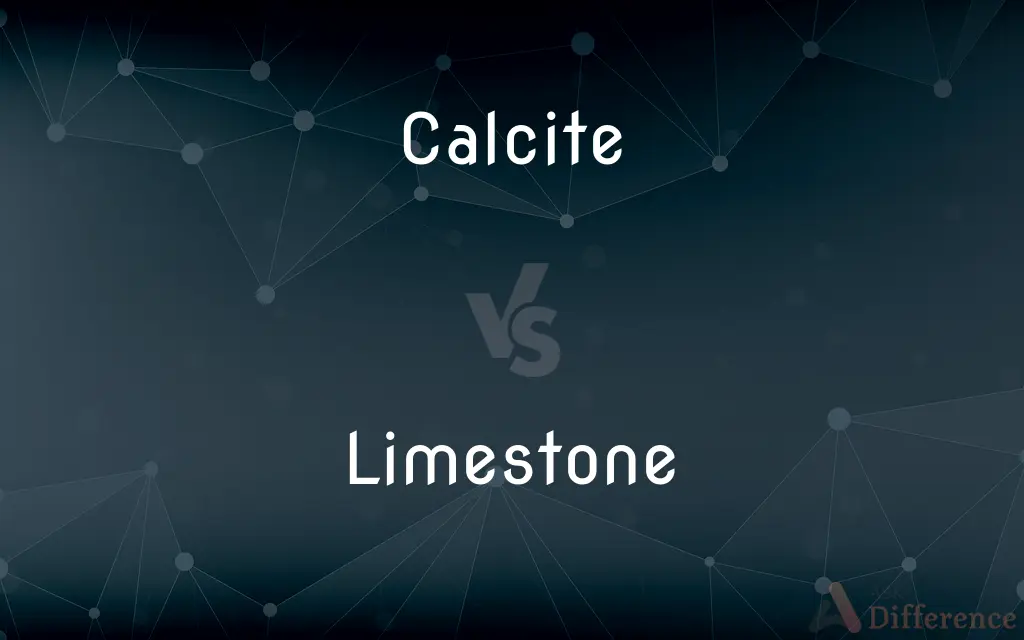Calcite vs. Limestone — What's the Difference?
Edited by Tayyaba Rehman — By Maham Liaqat — Updated on March 17, 2024
Calcite is a mineral composed primarily of calcium carbonate (CaCO3) and is the main component of limestone, which is a sedimentary rock. Limestone consists largely of calcite but also contains various amounts of other minerals and organic matter.

Difference Between Calcite and Limestone
Table of Contents
ADVERTISEMENT
Key Differences
Calcite is a crystalline form of calcium carbonate, known for its varied crystal shapes and its role in the formation of many types of sedimentary rocks, including limestone. It is not only a significant building block of limestone but also a key mineral in the shells of marine organisms, making it a major component of marine sediments. On the other hand, limestone is a rock primarily made up of calcite, formed either from the accumulation of the remains of marine organisms or from the direct precipitation of calcium carbonate from water.
The distinction between calcite and limestone lies in their nature; calcite is a mineral, a single substance with a definite chemical composition, while limestone is a rock composed of a mixture of minerals, primarily calcite, but often with impurities such as silica, clay, silt, and sand. These impurities can affect the color, texture, and structural integrity of limestone, making each limestone deposit unique.
In terms of uses, calcite is important in a wide range of applications, from the manufacture of cements and lime to the production of plastics, paints, and even in the pharmaceutical industry. Limestone, due to its calcite content, is extensively used in the construction industry for building materials and aggregate, and in the manufacturing of lime (CaO), which is an essential component of cement.
The formation processes of calcite and limestone also highlight their differences. Calcite forms in various environments, ranging from volcanic regions to hot springs and caverns, where it can create spectacular stalactites and stalagmites. Limestone, however, is typically formed in marine environments where the accumulation of calcite from marine organisms’ shells and skeletons over millions of years solidifies into rock.
Both calcite and limestone play significant roles in Earth’s carbon cycle. Calcite, through the formation and dissolution processes, acts as a natural reservoir for carbon dioxide. Limestone, as a calcite-rich rock, represents a major store of carbon over geological timescales, releasing carbon dioxide back into the atmosphere during the process of weathering or when it is heated during the production of lime and cement.
ADVERTISEMENT
Comparison Chart
Nature
Mineral
Rock
Composition
Calcium carbonate (CaCO3)
Primarily calcium carbonate (CaCO3), with impurities
Formation
Can form in various environments, including as a component of sedimentary rocks
Forms from the accumulation of calcite, especially from marine organisms, or through direct precipitation
Uses
In cements, lime, plastics, paints, pharmaceuticals
Building materials, aggregate, cement manufacturing
Texture and Appearance
Can exhibit various crystal forms; transparent to translucent
Generally opaque; texture varies from fine to coarse, depending on composition
Environmental Role
Acts as a carbon reservoir
Stores carbon over geological timescales; involved in the carbon cycle through weathering and heating
Compare with Definitions
Calcite
Found in sedimentary, metamorphic, and igneous rocks.
Calcite veins are often found in the fractures of sedimentary rocks.
Limestone
Varied in appearance due to impurities, can be white, gray, or colored by other minerals.
The limestone cliffs along the coastline have a distinct yellow hue due to iron oxide stains.
Calcite
Used in various industries for its chemical properties.
Calcite is a primary ingredient in the manufacture of paper and rubber.
Limestone
Used extensively in construction and industrial processes.
Limestone is quarried for use in the cement industry and for building stone.
Calcite
A mineral consisting of calcium carbonate, notable for its rhombohedral crystal structure.
Calcite crystals can exhibit a wide variety of shapes, including needles, prisms, and scalenohedra.
Limestone
A sedimentary rock composed mainly of calcite, often formed from marine organisms.
The Great Pyramid of Giza is made almost entirely from limestone blocks.
Calcite
Reacts vigorously with acids to produce carbon dioxide gas.
Geologists use dilute hydrochloric acid to test for calcite due to its strong effervescence.
Limestone
Acts as a significant carbon sink over geological time periods.
Limestone formations store vast amounts of carbon, making them important in studies of the carbon cycle.
Calcite
Calcite is a carbonate mineral and the most stable polymorph of calcium carbonate (CaCO3). The Mohs scale of mineral hardness, based on scratch hardness comparison, defines value 3 as "calcite".
Limestone
Limestone is a common type of carbonate sedimentary rock. It is composed mostly of the minerals calcite and aragonite, which are different crystal forms of calcium carbonate (CaCO3).
Calcite
A common crystalline form of natural calcium carbonate, CaCO3, that is the basic constituent of limestone, marble, and chalk. Also called calcspar.
Limestone
A common sedimentary rock consisting mostly of calcium carbonate, CaCO3, used as a building stone and in the manufacture of lime, carbon dioxide, and cement.
Calcite
(mineral) a very widely distributed crystalline form of calcium carbonate, CaCO3, found as limestone, chalk and marble
Limestone
An abundant rock of marine and fresh-water sediments; primarily composed of calcite (CaCO3); it occurs in a variety of forms, both crystalline and amorphous.
Calcite
Calcium carbonate, or carbonate of lime. It is rhombohedral in its crystallization, and thus distinguished from aragonite. It includes common limestone, chalk, and marble. Called also calc-spar and calcareous spar.
Limestone
Pertaining to or made of limestone.
Calcite
A common mineral consisting of crystallized calcium carbonate; a major constituent of limestone
Limestone
A rock consisting chiefly of calcium carbonate or carbonate of lime. It sometimes contains also magnesium carbonate, and is then called magnesian or dolomitic limestone. Crystalline limestone is called marble.
Limestone
A sedimentary rock consisting mainly of calcium that was deposited by the remains of marine animals
Common Curiosities
Can calcite be found in limestone?
Yes, calcite is the primary mineral component of limestone.
Are all limestones the same in texture and composition?
No, limestone can vary in texture from very fine to coarse and in composition based on the amount and type of impurities.
What is limestone?
Limestone is a sedimentary rock mainly composed of the mineral calcite, often formed from the skeletal remains of marine organisms.
How do calcite and limestone react with acid?
Both calcite and limestone react with dilute hydrochloric acid by fizzing or bubbling, releasing carbon dioxide gas.
What are the uses of limestone?
Limestone is used in construction, as a soil conditioner, and for the production of lime.
How can you identify calcite?
Calcite can be identified by its rhombohedral cleavage and its vigorous reaction with dilute hydrochloric acid.
What is calcite?
Calcite is a carbonate mineral, primarily composed of calcium carbonate (CaCO3), known for its varied crystal forms and colors.
Is limestone only formed from marine organisms?
While many limestones are formed from the remnants of marine organisms, some can also form from chemical precipitation.
What is the texture of calcite?
Calcite can exhibit a crystalline texture with well-defined rhombohedral cleavage planes.
Can calcite be found outside of limestone?
Yes, calcite is found in various geological environments, not just in limestone.
What are the uses of calcite?
Calcite is used in the manufacture of lime, cement, and as a flux in metallurgy.
How does the texture of limestone differ from that of pure calcite?
Limestone typically has a granular or clastic texture, which differs from the crystalline texture of pure calcite.
What role does calcite play in the formation of limestone?
Calcite, being the primary mineral in limestone, contributes to its formation, especially from the accumulation and compaction of marine organism remains.
What is the significance of the color variation in calcite?
The color variation in calcite is significant for mineral collectors and can indicate the presence of certain impurities or conditions during its formation.
How does the acid reaction test help in distinguishing calcite from other minerals?
The vigorous fizzing reaction of calcite with dilute hydrochloric acid is a distinctive test that helps distinguish it from most other minerals, which either do not react or react less intensely.
Share Your Discovery

Previous Comparison
Fashion vs. Trend
Next Comparison
Argument vs. ExplanationAuthor Spotlight
Written by
Maham LiaqatEdited by
Tayyaba RehmanTayyaba Rehman is a distinguished writer, currently serving as a primary contributor to askdifference.com. As a researcher in semantics and etymology, Tayyaba's passion for the complexity of languages and their distinctions has found a perfect home on the platform. Tayyaba delves into the intricacies of language, distinguishing between commonly confused words and phrases, thereby providing clarity for readers worldwide.
















































